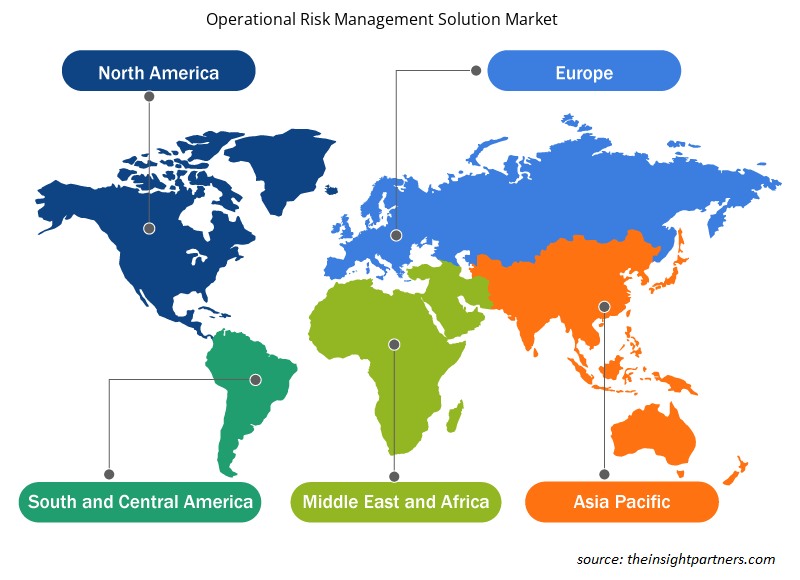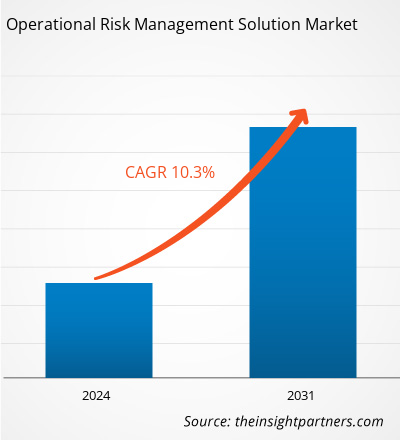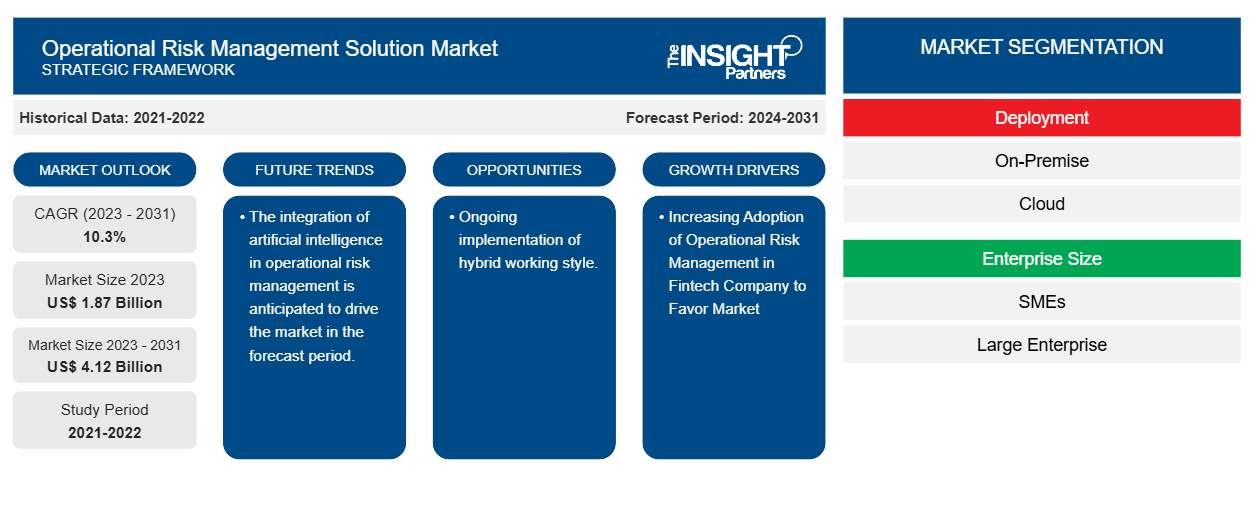Si prevede che la dimensione del mercato delle soluzioni di gestione del rischio operativo raggiungerà i 4,12 miliardi di dollari entro il 2031, rispetto agli 1,87 miliardi di dollari del 2023. Si prevede che il mercato registrerà un CAGR del 10,3% nel periodo 2023-2031. La crescente adozione della gestione del rischio operativo nelle aziende fintech e l'aumento dei casi di attacchi informatici in varie organizzazioni saranno probabilmente i principali fattori trainanti e tendenze nel mercato delle soluzioni di gestione del rischio operativo.
Analisi di mercato delle soluzioni di gestione del rischio operativo
Il mercato della gestione del rischio operativo sta vivendo una crescita significativa a livello globale. Questa crescita è attribuita alla crescente adozione della gestione del rischio operativo nelle aziende fintech e all'aumento dei casi di attacchi informatici in varie organizzazioni. Inoltre, si prevede che l'implementazione in corso di stili di lavoro ibridi e l'integrazione dell'intelligenza artificiale nella gestione del rischio operativo offriranno opportunità significative per il mercato della gestione del rischio operativo nei prossimi anni.
Panoramica del mercato delle soluzioni di gestione del rischio operativo
La gestione del rischio operativo (ORM) è un processo che comprende la valutazione del rischio, il processo decisionale e l'esecuzione del controllo del rischio per ridurre tali minacce a livelli appropriati. La gestione del rischio operativo rivolta a tutti i settori e le industrie, inclusi i rischi operativi per banche e servizi finanziari, apparirà diversa dai rischi operativi per una struttura manifatturiera. In definitiva, un solido processo di gestione del rischio operativo è necessario per qualsiasi organizzazione per evitare problemi potenzialmente disastrosi e garantire la continuità aziendale.
Personalizza questo report in base alle tue esigenze
Riceverai la personalizzazione gratuita di qualsiasi report, comprese parti di questo report, o analisi a livello nazionale, pacchetto dati Excel, oltre a usufruire di grandi offerte e sconti per start-up e università
-
Scopri le principali tendenze di mercato in questo rapporto.Questo campione GRATUITO includerà analisi di dati che spaziano dalle tendenze di mercato alle stime e alle previsioni.
Driver di mercato e opportunità per le soluzioni di gestione del rischio operativo
Crescente adozione della gestione del rischio operativo nelle aziende FinTech per favorire il mercato
La crescente adozione della gestione del rischio operativo nelle aziende fintech sta davvero guidando il mercato. La tecnologia e le industrie finanziarie si stanno espandendo a un ritmo rapido, così come il numero di aziende nel settore. Le aziende fintech affrontano esigenze normative rigorose. Con l'aumento del numero di aziende, aumenta anche la domanda di conformità e normative. Inoltre, le aziende fintech comprendono vari dati finanziari con informazioni sensibili e questi dati non possono permettersi di essere violati. La soluzione di gestione del rischio operativo qui aiuta e impedisce la violazione dei dati delle aziende fintech . Pertanto, considerando i parametri di cui sopra, la crescente adozione della gestione del rischio operativo nelle aziende fintech sta guidando la crescita del mercato delle soluzioni di gestione del rischio operativo.fintech companies is indeed driving the market. The finance technology and industries are expanding at a fast pace, and so is the number of companies in the industry. Fintech companies face stringent regulatory needs. As the number of companies grows, the demand for compliance and regulations increases. Moreover, fintech companies comprise various financial data with sensitive information, and this data cannot afford to be breached. The operational risk management solution here helps and prevents the fintech companies is driving the operational risk management solution market growth.
Implementazione continua dello stile di lavoro ibrido.
Si prevede che l'implementazione in corso di uno stile di lavoro ibrido offra diverse opportunità per il mercato. L'ambiente di lavoro ibrido dipende da un'infrastruttura complessa e necessita di una solida infrastruttura IT per gestire i dipendenti che lavorano da remoto e quelli che lavorano in ufficio. Inoltre, la criminalità informatica continua a crescere in sofisticatezza e le aziende che adottano un modello di lavoro ibrido devono mantenere la vigilanza con solidi controlli sulla sicurezza dei dati. I modelli di lavoro ibrido presentano rischi quali standard di sicurezza informatica meno rigidi, fidelizzazione del personale e molto altro. Le soluzioni di gestione del rischio operativo offrono prevenzione per questi rischi. Pertanto, considerando i parametri di cui sopra, si prevede che l'implementazione in corso di uno stile di lavoro ibrido offra diverse opportunità per il mercato.cybercrime continues to grow in sophistication, and businesses adopting a hybrid work model must maintain their vigilance with robust controls surrounding data security. The hybrid work models have risks such as cyber security relaxed standards, staff retention, and many more. Operational risk management solutions offer prevention for these risks. Thus, considering the above parameters, the ongoing implementation of a hybrid working style is anticipated to hold several opportunities for the market.
Analisi della segmentazione del rapporto di mercato delle soluzioni di gestione del rischio operativo
I segmenti chiave che hanno contribuito alla derivazione dell'analisi di mercato delle soluzioni di gestione del rischio operativo sono l'implementazione e le dimensioni aziendali.
- In base all'implementazione, il mercato delle soluzioni di gestione del rischio operativo è suddiviso in on-premise e cloud. Si prevede che il segmento on-premise detenga una quota di mercato significativa nel periodo di previsione.
- In base alle dimensioni aziendali, il mercato delle soluzioni di gestione del rischio operativo è suddiviso in PMI e grandi imprese. Si prevede che il segmento PMI deterrà una quota di mercato significativa nel periodo di previsione.SMEs and large enterprises. The SME segment is anticipated to hold a significant market share in the forecast period.
Analisi della quota di mercato delle soluzioni di gestione del rischio operativo per area geografica
L'ambito geografico del rapporto di mercato sulle soluzioni di gestione del rischio operativo è suddiviso principalmente in cinque regioni: Nord America, Asia Pacifico, Europa, Medio Oriente e Africa, e Sud e Centro America.
Il Nord America ha dominato il mercato delle soluzioni di gestione del rischio operativo. Il mercato nordamericano è segmentato in Stati Uniti, Canada e Messico. Il mercato sta vivendo una crescita significativa nelle regioni. Questa crescita è attribuita al crescente ambiente di lavoro ibrido nella regione. Le tendenze di adozione di tecnologie elevate in vari settori nella regione nordamericana hanno alimentato la crescita del mercato delle soluzioni di gestione del rischio operativo. Si prevede che fattori come l'adozione crescente di strumenti digitali e l'elevata spesa tecnologica da parte delle agenzie governative guideranno la crescita del mercato delle soluzioni di gestione del rischio operativo nordamericano.fuelled the growth of the operational risk management solution market. Factors such as increased adoption of digital tools and high technological spending by government agencies are expected to drive the North American operational risk management solution market growth.
Inoltre, una forte enfasi sulla ricerca e sviluppo nelle economie sviluppate degli Stati Uniti e del Canada sta costringendo i player nordamericani a portare sul mercato soluzioni tecnologicamente avanzate. Inoltre, gli Stati Uniti hanno un gran numero di player del mercato delle soluzioni di gestione del rischio operativo che si sono sempre più concentrati sullo sviluppo di soluzioni innovative. Tutti questi fattori contribuiscono alla crescita del mercato delle soluzioni di gestione del rischio operativo nella regione.
Panoramica regionale del mercato delle soluzioni di gestione del rischio operativo
Le tendenze regionali e i fattori che influenzano il mercato delle soluzioni di gestione del rischio operativo durante il periodo di previsione sono stati ampiamente spiegati dagli analisti di Insight Partners. Questa sezione discute anche i segmenti e la geografia del mercato delle soluzioni di gestione del rischio operativo in Nord America, Europa, Asia Pacifico, Medio Oriente e Africa e America centrale e meridionale.

- Ottieni i dati specifici regionali per il mercato delle soluzioni di gestione del rischio operativo
Ambito del rapporto di mercato sulla soluzione di gestione del rischio operativo
| Attributo del report | Dettagli |
|---|---|
| Dimensioni del mercato nel 2023 | 1,87 miliardi di dollari USA |
| Dimensioni del mercato entro il 2031 | 4,12 miliardi di dollari USA |
| CAGR globale (2023-2031) | 10,3% |
| Dati storici | 2021-2022 |
| Periodo di previsione | 2024-2031 |
| Segmenti coperti |
Per distribuzione
|
| Regioni e Paesi coperti |
America del Nord
|
| Leader di mercato e profili aziendali chiave |
|
Soluzioni di gestione del rischio operativo Densità dei player del mercato: comprendere il suo impatto sulle dinamiche aziendali
Il mercato delle soluzioni di gestione del rischio operativo sta crescendo rapidamente, spinto dalla crescente domanda degli utenti finali dovuta a fattori quali l'evoluzione delle preferenze dei consumatori, i progressi tecnologici e una maggiore consapevolezza dei vantaggi del prodotto. Con l'aumento della domanda, le aziende stanno ampliando le loro offerte, innovando per soddisfare le esigenze dei consumatori e capitalizzando sulle tendenze emergenti, il che alimenta ulteriormente la crescita del mercato.
La densità degli operatori di mercato si riferisce alla distribuzione di aziende o società che operano in un particolare mercato o settore. Indica quanti concorrenti (operatori di mercato) sono presenti in un dato spazio di mercato in relazione alle sue dimensioni o al valore di mercato totale.
Le principali aziende che operano nel mercato delle soluzioni di gestione del rischio operativo sono:
- Adattare IT Holdings Ltd
- Flusso metrico
- Sicurezza RSA
- Società a responsabilità limitata
- SAP SE
- Shell International BV
Disclaimer : le aziende elencate sopra non sono classificate secondo un ordine particolare.

- Ottieni la panoramica dei principali attori del mercato della soluzione di gestione del rischio operativo
Notizie di mercato e sviluppi recenti sulle soluzioni di gestione del rischio operativo
Il mercato delle soluzioni di gestione del rischio operativo viene valutato raccogliendo dati qualitativi e quantitativi dopo la ricerca primaria e secondaria, che include importanti pubblicazioni aziendali, dati associativi e database. Di seguito sono elencati alcuni degli sviluppi nel mercato delle soluzioni di gestione del rischio operativo:
- L'Australian Prudential Regulation Authority (APRA) ha annunciato la finalizzazione del Prudential Standard CPS 230 Operational Risk Management (CPS 230). Secondo l'APRA, il CPS 230 mira a migliorare la capacità delle entità regolamentate dall'APRA di gestire i rischi operativi e affrontare le interruzioni aziendali. (Fonte: sito Web aziendale APRA, luglio 2023)
- Tata Consultancy Services (TCS) ha lanciato una soluzione di monitoraggio basata sul rischio agile e intuitiva per gli studi clinici che consente un processo decisionale intelligente, una maggiore conformità e migliora l'efficacia dello studio. (Fonte: sito Web aziendale TCS, aprile 2022)
Copertura e risultati del rapporto di mercato sulla soluzione di gestione del rischio operativo
Il rapporto “Dimensioni e previsioni del mercato delle soluzioni di gestione del rischio operativo (2021-2031)” fornisce un’analisi dettagliata del mercato che copre le seguenti aree:
- Dimensioni e previsioni del mercato delle soluzioni di gestione del rischio operativo a livello globale, regionale e nazionale per tutti i segmenti di mercato chiave coperti dall'ambito
- Tendenze del mercato delle soluzioni di gestione del rischio operativo e dinamiche di mercato come driver, vincoli e opportunità chiave
- Analisi dettagliata delle cinque forze PEST/Porter e SWOT
- Analisi di mercato delle soluzioni di gestione del rischio operativo che copre le principali tendenze del mercato, il quadro globale e regionale, i principali attori, le normative e i recenti sviluppi del mercato
- Analisi del panorama industriale e della concorrenza che copre la concentrazione del mercato, l'analisi della mappa di calore, i principali attori e gli sviluppi recenti per il mercato delle soluzioni di gestione del rischio operativo
- Profili aziendali dettagliati
- Analisi storica (2 anni), anno base, previsione (7 anni) con CAGR
- Analisi PEST e SWOT
- Valore/volume delle dimensioni del mercato - Globale, Regionale, Nazionale
- Industria e panorama competitivo
- Set di dati Excel
Report recenti
Rapporti correlati
Testimonianze
Motivo dell'acquisto
- Processo decisionale informato
- Comprensione delle dinamiche di mercato
- Analisi competitiva
- Analisi dei clienti
- Previsioni di mercato
- Mitigazione del rischio
- Pianificazione strategica
- Giustificazione degli investimenti
- Identificazione dei mercati emergenti
- Miglioramento delle strategie di marketing
- Aumento dell'efficienza operativa
- Allineamento alle tendenze normative























 Ottieni un campione gratuito per - Mercato delle soluzioni di gestione del rischio operativo
Ottieni un campione gratuito per - Mercato delle soluzioni di gestione del rischio operativo